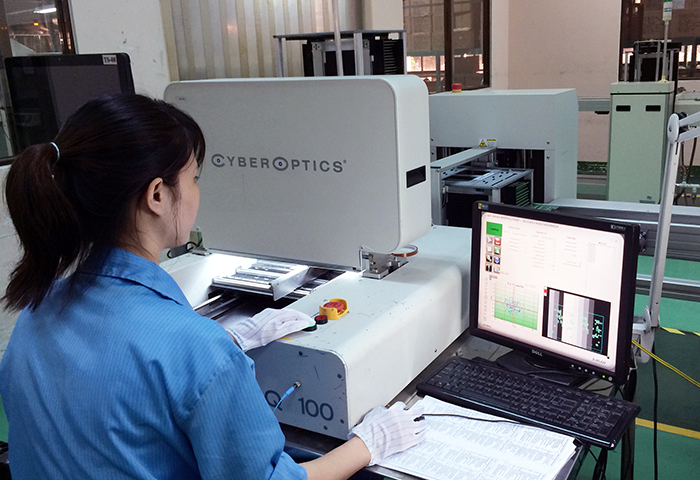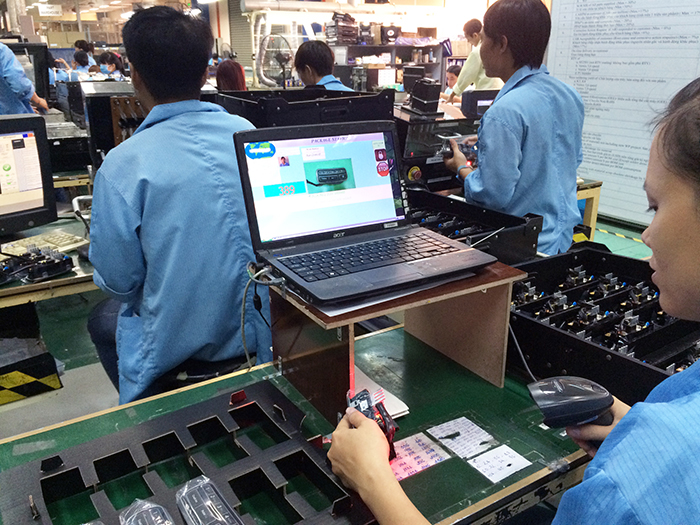Lean Systems Strategy for Low-Cost Countries

Linking facility systems to a standard corporate platform reduces inventory, improves response time to demand changes and enhances internal communication.
There was a time when the tradeoff that came with a low labor rate was less flexibility, less technical expertise and less automation. The theory was that since labor was often the biggest cost savings, investments in capital equipment and systems should be minimized. However, that premise is becoming an old school thought in a world where the costs of inflexibility, excess inventory and poor quality quickly trump any savings achievable by accessing low-cost labor markets. That said, what levels of automation and systems visibility make sense in low-cost markets?
SigmaTron applied Lean manufacturing principals to enhance the systems capabilities of its facility in Biên Hòa, Dong Nai province, Vietnam. Our systems strategy is focused on four key areas, detailed below. A mix of standardized system platforms are combined with a suite of internally developed software to support areas the core off-the-shelf systems don’t handle as well. Systems cost is easily offset by reductions in engineering labor, excess inventory and cycle times.

Figure 1. A robust inspection and test strategy, which includes AOI, is used to ensure any quality issues are identified as early in the production process
as possible.
1. Minimizing nonrecurring engineering (NRE) activities. The facility is in the process of migrating to a paperless factory. This reduces the potential for manually induced errors in documentation transfer and programming, plus the overall time required for new product introduction (NPI) activities. Manual entry of documentation has been eliminated for both materials and manufacturing engineering-related activities. Bills of material (BoMs) are loaded into a Macola ES ERP system to drive materials acquisition. All documentation is also released into an Agile product lifecycle management system, which automates data transfer and creation of manufacturing documentation.
2. Eliminating defect opportunities. Design for manufacturability (DfM) analysis is performed at the start of every project using Valor tools. The documentation review process uses a Valor parts library to verify all BoM component footprints against land patterns used in the layout. This helps eliminate both the opportunity for defects caused by manufacturability issues and the non-value-added time spent reprogramming machines or respinning the board layout if component packaging specified in BoM doesn’t match the land patterns used in the layout.
Test and inspection strategy includes AOI and electrical and functional testing. Functional test systems include a machine vision test that verifies products with LED control panels have adequate light levels and colors.
Systems strategy is also applied here, as internally developed MES software called Tango is used to integrate shop floor control, quality data collection and traceability activities. All material is barcoded at incoming inspection, and kitting priorities are set based on demand trends. Products are tracked through all production processes associated with that work order. Placement and insertion equipment self-checks any feeders based on the work order. If a production process set is missed, operators cannot scan the barcode until the missing step is completed. Additionally, it tracks the actual operators associated with each production step, the revision level of any software loaded in the unit and the number of units completed.
At the end of the process, a Customer Advocacy Audit (CAA) is performed via a sample plan and inspection strategy designed to ensure at a 99.9% confidence level no defects are present. If the sample fails inspection, the entire shipment is inspected. While there is a cost associated with both sampling and any required inspections, it is far less than the cost incurred if the shipment was rejected at the customer.
From a defect prevention standpoint, the lockout mechanism makes it impossible to skip production steps or load incorrect components into placement equipment. From a traceability standpoint, the system maintains a device history record which includes components used, production processes completed, operators associated with assembly activities and test results. This level of data supports quick resolution of any quality issues that could potentially develop.
3. Shared systems for maximized visibility. While functionally specific suites of software are helpful in eliminating non-value-added activity or muda, having a system capable of linking this information across the internal staff, supply chain and customers is critical to reaping maximum benefits from a strong systems strategy. SigmaTron uses an industry standard ERP system enhanced with an internally developed tool suite across all facilities, accessible by suppliers via an iScore interface. Through this tool suite, the Vietnam facility and the IPO have visibility into forecasted demand, actual demand, inventory in each facility and inventory on order. Materials systems are linked globally to provide company-wide visibility into inventory levels and materials status. Data from Tango are also linked to the ERP system through iScore, but not available yet externally through Score. Customers can access Score 24/7 via the internet for project status visibility, and program management uses iScore to stay abreast of key project metrics.
This system strategy also provides country-specific benefits. Under Vietnam customs regulations, manufacturers must be able to provide proof that incoming material is appropriately consumed in the manufacturing process and shipped out, to minimize the potential for black market material sales to the local market. The material tracking data stored by Tango are used to document material import, transformation and shipment for customs purposes, which eliminates the need for manual tracking.
Similarly, iScore and the ERP system support program management activities by making easy-to-run “what if” analyses when demand trends are changing or an engineering change order needs to be implemented. These types of “what if” analyses reduce the time to gather the necessary information on available inventory, cost and lead-time from days to fewer than 24 hr.
4. Maximizing economies of scale. Centers of expertise for engineering and procurement share these resources throughout the company. While every facility has an engineering staff, DfM is performed by an engineering team located at the company’s Suzhou facility, and test engineering development is supported by a test engineer at our subsidiary Spitfire Controls’ design facility in Elgin, IL. Similarly, while there is a local purchasing team within the Vietnam facility, the bulk of purchasing is handled through the company’s International Purchasing Office (IPO) in Taiwan. The IPO and distribution partners in each region act as “single” suppliers for most materials, increasing efficiency by consolidating orders. Program managers reside in the US to be in closer proximity to end-customers. Customer service representatives in Vietnam coordinate with US-based program managers. In addition to maximizing economies of scale, leveraging centers of expertise provides more flexibility in supporting tight deadlines or unusually heavy engineering workloads. It also improves customer service by placing resources in close time zone proximity to their counterparts at the customer. This standardized systems strategy ensures remote team members have the same tools and visibility into project requirements as the Vietnam facility team.
Vietnam offers a highly educated and dedicated workforce, and the systems strategy ensures employees receive real-time feedback on the quality of their efforts. The compensation program includes a quarterly pay-for-performance element that is eliminated if even one shipment is rejected anywhere in the world. The facility has had zero rejected shipments since its inception in 2005. On-time delivery is 100%, and there have been zero late shipments since 2005. The bar is set high because rejected product not only creates potential inventory shortages at the customer. It also represents wasted logistics cost and wasted time expended in transit and repair. The facility’s inventory turns are averaging slightly over seven turns annually.

Figure 2. An operator barcodes a product prior to packaging for shipment. The shop floor control system will not permit the barcode to log in if all prior steps are not complete.
is general manager and director of operations, Vietnam at SigmaTron International (sigmatronintl.com); peter.sognefest@sigmatronintl.com.







